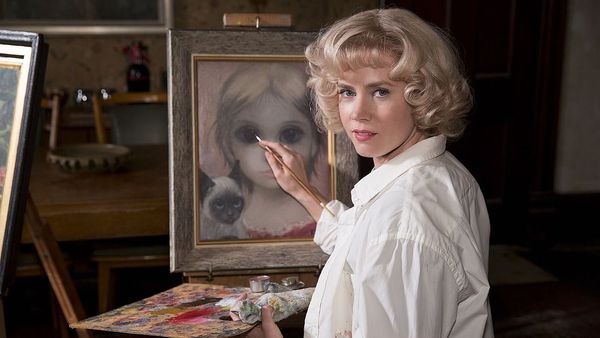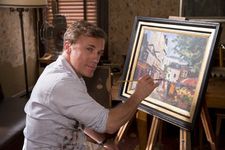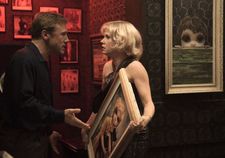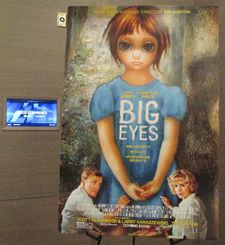 |
| Amy Adams as Margaret Keane in Tim Burton's Big Eyes: "Her nature is very internal." |
The Weinstein Company's Tim Burton Big Eyes press conference at the Park Hyatt Hotel included Amy Adams, Christoph Waltz, Danny Huston, Krysten Ritter, Jason Schwartzman with writers Scott Alexander and Larry Karaszewski. Tim Burton relived the passion of Ed Wood and revealed that his children can watch Sleepy Hollow and Sweeney Todd: The Demon Barber Of Fleet Street and not Big Eyes. Waltz and Adams spoke about their relationship to portraying Walter Keane and Margaret Keane. Schwartzman and Karaszewski referenced the impact of the art world and Terence Stamp's John Canaday. Alexander saw a Marx Brothers scene that was toned down for Big Eyes and Alexander Mackendrick's Sweet Smell Of Success turns out to have been a big influence after Vincente Minnelli's An American In Paris was brought up.
 |
| Christoph Waltz as Walter Keane: "If he weren't likable, you wouldn't have a story." |
The biopic paints a vivid portrait of the Keanes' relationship and how through kitsch, commerce and fraud, they shook up the molecules of the art world in the early 1960s. The paintings of big-eyed forlorn orphans, each clutching a puppy, a kitten, a flower or some bright object to heighten their forlornness, that Walter took credit for and promoted brilliantly and unscrupulously, were actually produced solely by his wife Margaret. Amy Adams in a nuanced and tender performance leads us deeply into the dilemma of a single mother and artist in mid-century America. Burton shows her locked in the secrecy of her closet atelier, hiding the truth from everyone, even her own daughter while Walter revolutionises the mass production of suburban art in a wild song and dance routine, convinced that nobody will ever find out the truth.
Christoph Waltz's Rumpelstiltskin-like Walter pulls the strings maniacally on what looks like the set of an Arthur Freed musical for MGM and exemplifies that putting a name on something doesn't make it yours. An American In Paris gives birth from Andy Warhol to Jeff Koons. The plot of Singin' In The Rain credits the real artist and Margaret Keane learns how to stand up for herself. Krysten Ritter's DeeAnn suspects foul play all along, while Danny Huston's newspaper columnist Dick Nolan profits heavily himself from Walter's shenanigans.
Anne-Katrin Titze: The mood of the film is a very interesting mix. On the one hand, I felt I was in an Arthur Freed production - there is some An American In Paris (1951) in [Walter's older] paintings. On the other hand it seemed like a re-writing of Rumpelstiltskin where the queen is the one who can spin straw into gold and he just sells it very well. I am interested in fictional references that might have been there, aside from their life story.
 |
| Tim Burton's Big Eyes press conference: "It's like Big Brother watching you with those big eyes. And the polarised responses to it." Photo: Anne-Katrin Titze |
Scott Alexander: A big headstone for us jumping off was the Sweet Smell of Success (1957) about a press journalist and publicist of New York nightlife of the 1950s and his desperate need to get his names in the paper every day. It all takes place against the backdrop of jazz clubs. Everyone's dressed up really well. Everyone's got a martini in their hand and everybody's trying to quarrel with each other to get their name in the paper. That was a big influence for us.
Larry Karaszewski: The movie does have a mixture of a lot of things. Tim is great with this and that's why we work very well together. One minute it's a comedy and a love story and then it becomes a Hitchcockian thriller. Sometimes it's all of these things in one scene.
Tim Burton explained the genesis and pervasiveness of the "Big Eyes" for him and the critics' response to his art exhibition at New York's Museum of Modern Art.
Tim Burton: I grew up with it [the Keane paintings]. It was very present. I always liked suburban art. It was in people's living rooms, the doctor's office, the dentist's office. It was culturally just very present in the society that I grew up in. I find it quite disturbing, actually. It's like Big Brother watching you with those big eyes. And the polarised responses to it. Some people loved it, obviously, some people just wanted to rip it off the walls. That kind of response I found quite fascinating…
 |
| Larry Karaszewski on Walter and Margaret Keane in Big Eyes: "One minute it's a comedy and a love story and then it becomes a Hitchcockian thriller." |
There's a fine line what's perceived as good and bad [art]. I experienced that myself, when I had the MoMA show [November 22, 2009 - April 26, 2010] here. To the critics I was a hundred times worse than Walter Keane. I got so lambasted and at the same time it had a high attendance. If you do something that you are very passionate about, whether it's like Ed Wood, or Keane, there's just such enthusiasm. You understand that kind of enthusiasm and you understand a certain kind of polarization of people's responses.
Christoph Waltz [about his character Walter Keane]: What's not to like? I don't get it. If he weren't likable, you wouldn't have a story. Why would Margaret hook up with an unlikable character? The relationship only makes sense when to some degree you can identify with it… The pressure of market economy is something that brings up the worst in all of us.
Amy Adams [about Margaret Keane]: Her nature is very internal. I believe she to this day gives Walter credit. The thing that I liked about Margaret and why I didn't want her to feel like a victim, she takes responsibility. I like her sense of ownership… I think it happened at the same time that she felt compelled to tell the truth and she became a Jehovah's Witness. That's a part of why she wanted to tell the truth and why she still takes responsibility.
 |
| Big Eyes press conference poster |
Jason Schwartzman [about his role as the gallery owner Ruben]: In the art world there are so many people that make the machine work. A gallery owner is someone who represents what is going to be sold. It was a fun character to play, especially to Walter who is becoming quite violent, as the gatekeeper of the street.
Larry Karaszewski: It's funny, we showed the movie at Miami Art Basel and it was to an audience of nothing but the Jason Schwartzman character, gallery owners and Terence Stamps [who plays art critic John Canaday].
The Keanes' relationship culminates in a trial about who the real artist is.
Scott Alexander [on writing the trial]: We got a lot from the Hawaiian papers and it was a Marx Brothers scene. It was so extreme that we had to cut jokes out. Walter's behavior was so erratic. By the end of the trial, he [defending himself] was really delusional, he really believed he was a lawyer. He was running back and forth to the witness box, interrogating himself.
Tim Burton: Understanding the culture that I grew up in, sort of the end of the American Dream, sort of this dysfunctional couple [the Keanes] coming together creating these children, just felt like my family. So I came at it in a strange way. I will never show this film to my children. I'll show them Sleepy Hollow and Sweeney Todd but not this one.
Big Eyes opens in the US on December 25 and in the UK on December 26.





















